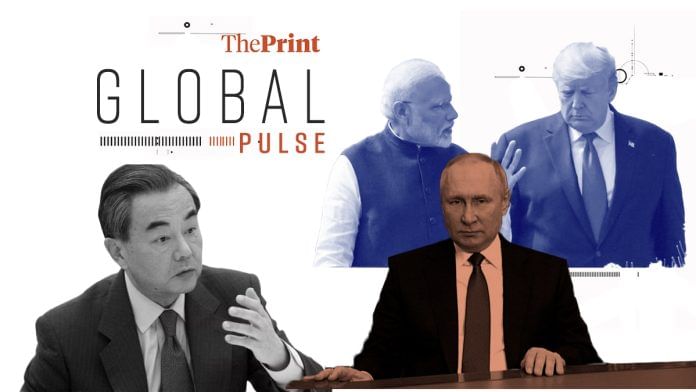New Delhi: China’s Foreign Minister Wang Yi’s visit to India is a clear indicator that “bilateral ties are steadily warming”, says Chinese mouthpiece Global Times in an editorial, pointing to a “pragmatic reset”. Talks on resuming trade and direct flights are supposedly underway, and “friction points” along the Line of Actual Control “have seen disengagement”.
“Several factors explain why relations are improving now. First, profound shifts in the international landscape have heightened the shared desire for multipolarity and strategic autonomy, particularly regarding BRICS cooperation. With supply chains being reconfigured and geopolitical flashpoints multiplying, major Asian economies are seeking to reduce bloc-based risks and preserve policy flexibility,” it reads.
The New York Times delves into how China stands to seriously benefit from the fallout between Prime Minister Narendra Modi and US President Donald Trump. The souring of ties between the two leaders has “injected new momentum” into the India-China relationship, a “thaw” that appears to be deepening, report David Pierson and Alex Travelli.
“The Modi government has also been careful not to raise the Indian public’s ire over the way China helped Pakistan’s military during a clash with Indian forces in May—a sign of New Delhi’s commitment to smoother relations with Beijing,” the report reads.
“I assume that there is a certain amount of schadenfreude among some folks in Beijing when they look at the trade issues between India and the United States,” Manoj Kewalramani, head of Indo-Pacific studies at Bengaluru’s Takshashila Institution, has been quoted as saying. “A breakdown of political trust between New Delhi and Washington works in Beijing’s favour.”
CNN’s Fareed Zakaria also weighs in on the collapse of India-US ties––going as far as calling it “the biggest strategic mistake of Trump’s presidency so far”.
“A close relationship between Washington and New Delhi would be key to preventing the Chinese domination of Asia and securing America’s interests in the region,” he said, explaining the genesis of the relationship. “Enter Trump 2.0. With little warning, Donald Trump has undone decades of painstaking effort by American diplomats.”
In an article in the Financial Times, titled “India’s oil lobby is funding Putin’s war machine—that has to stop”, White House trade and manufacturing counsellor Peter Navarro gives his take on the “India-Russia oil mathematics”. American consumers buy Indian goods, and India promptly spends that money on discounted Russian crude. “That Russian crude is refined and resold around the world by Indian profiteers in league with silent Russian partners—while Russia pockets hard currency to fund its war machine in Ukraine.”
Navarro writes, “As Russia continues to hammer Ukraine, helped by India’s financial support, American (and European) taxpayers are then forced to spend tens of billions more to help Ukraine’s defence. Meanwhile, India keeps slamming the door on American exports through high tariffs and trade barriers. More than 300,000 soldiers and civilians have been killed, while Nato’s eastern flank grows more exposed and the west foots the bill for India’s oil laundering.”
Last week, both India and Pakistan celebrated their Independence Days. And the celebrations pointed to a different kind of symbolic warfare on the border—Indian soldiers raced to place the tricolour so that it “towers” above the Pakistan flag, reports Penelope MacRae for The Guardian.
“This year’s flagpole frontline is Sadqi, a quiet patchwork of wheat fields in northern Punjab state’s Fazilka district. India’s Tiranga, or tricolour, will fly from a new 200-foot (61-metre) galvanised-iron mast. Across the barbed-wire frontier at Sulemanki, Pakistan’s green-and-white Parcham-e-Sitāra-o-Hilāl flutters from a 165-foot (50-metre) pole,” the report reads.
“While this ‘flagpole war’ might look like just a symbolic contest, it’s freighted with emotional and nationalist overtones, especially in the context of the India-Pakistan rivalry, where tensions touch people’s lives on both sides,” Indian military expert Rahul Bedi is quoted as saying.
(Edited by Mannat Chugh)






